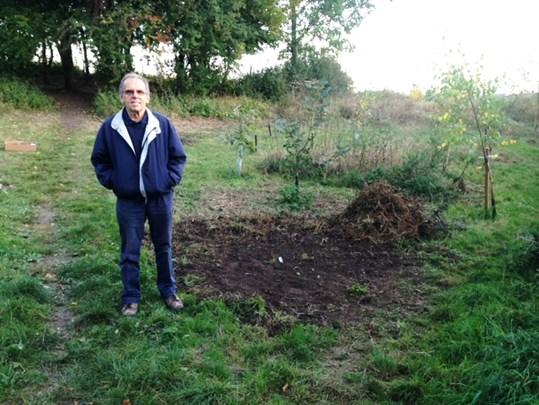
4 minute read
Suffolk Birds 2015 available Suffolk Naturalists’ Society More Scattered Orchards and New Pollinator Patches
The enthusiasm of HLF for the Trust’s vision brings the project a step closer and Suffolk Wildlife Trust is now launching a £1million fundraising campaign towards the land purchase. Julian Roughton, chief executive of Suffolk Wildlife Trust said: “This is an opportunity to create wildness as far as the eye can see and restore a magnificent landscape in the UK’s most nature-rich National Park. Buying this land will create an amazing place for wildlife that people can enjoy forever. It’s an ambitious vision and raising £1million will enable us to make it happen.” Kerry Stranix, Suffolk Wildlife Trust’s Communications and Fund Raising Manager, said “As at 12th December we had raised £279,713. It’s a fabulous start to be over a quarter of the way there before Christmas. But we still have a long way to go. It’s very easy to support the appeal. You can donate online at suffolkbroads.org.uk - and you can even sponsor an area of the new reserve as a Christmas present, with a gift certificate to send on to the recipient. (Much better than socks!). We are tremendously grateful to everyone who has given their kind support and hope that everyone will help us spread the word about this fabulous opportunity.”
Each donation will effectively be tripled by the legacy gifts the Trust has already received, Gift Aid and through the charity’s approaches to funders like the Heritage Lottery Fund.
Looking over the reserve and the new land flying
north. Oulton Broad can be seen top right. Photo taken
from a drone by John Lord Marsh Harrier. Photo Paul Sawer

Suffolk Birds 2015 available
Suffolk Naturalists’ Society
Suffolk Birds 2015 Vol 65 is hot off the press and available now from Ipswich Museum and RSPB Minsmere. The report is published by Suffolk Naturalists’ Society and compiled by Suffolk Ornithologists’ Group. The editor is Nick Mason, greatly assisted by Philip Murphy with photos by Bill Baston and artwork by Phil Whittaker. The Black-browed Albatross on the front cover was seen at RSPB Minsmere on 12th July 2015! Cost: £10 to collect or £12 with postage & packing Suffolk Dragonflies, edited by Nick Mason and Adrian Parr, is also available at the same price - published in September 2016, this new book provides a comprehensive update on the fortunes of Suffolk’s dragonflies. To order online, visit SNS > or collect from Ipswich Museum / RSPB Minsmere.

Emma Black, Dedham Vale AONB and Stour Valley Project

Fruit tree planting in conservation area / allotments in Assington
After the success of the Dedham Vale and Suffolk Coast & Heaths AONB Scattered Orchard Projects (SOP) last year, which saw the planting of 168 traditional fruit and nut trees at 36 sites in the Suffolk/Essex Areas of Outstanding Natural Beauty (AONBs), funding has been secured to extend the SOP into the rest of the Stour Valley and to some other sites in the Suffolk Coast and Heaths, thanks to the Stour Valley Environment Fund and Galloper Wind Farm Fund. So far 17 sites have been allocated trees. It will be a joy to watch these scattered orchards maturing over time, seeing their blossom in the spring and local communities foraging for the fruit in the autumn. As well as extending this project, we want to continue working with the various community stakeholders we worked with in 2015 on a project to increase the number and diversity of nectar rich plants beneficial to pollinators, particularly bees, at each SOP site. Some fruit trees are planted in sites with little floristic diversity so planting nectar rich plants will not only increase the biodiversity of the area but will help with the pollination of the fruit trees.
We have called this new project ‘Pollinator Patches’ and its aim is to plant native bulbs, wildflower plugs/ seed and small trees and shrubs which provide nectar and pollen beneficial to pollinators throughout the year. This scheme will involve the local community in the planting so will continue to bring local people together on a project that will be there for future generations to enjoy. So far we have run a training session for volunteers with Gen Broad, Suffolk Biodiversity Information Service Biodiversity Officer, on wildflower identification and site surveys. These volunteers then visited the SOP sites and identified what habitat was already at each of the sites, what could be done to improve wildlife value and where the best places were for pollinator patches. The local community have planted spring bulbs, wildflower plugs and sown wildflower seed such as yellow rattle. The small trees and shrubs such as pussy willow and crab apple will be planted in the winter alongside snowdrops and aconites in the green.

Wildflower planting in Bures Community woodland
Information boards will be installed to raise awareness about the projects, what has been planted and why and the posters and flyers distributed locally to raise awareness of what people can do to increase pollinators to their gardens.
To promote the idea of ‘pollinator patches’ to a wider audience there will be an event held early in the new year in each AONB where wildflower seed and snowdrops / aconites in the green will be given out.






